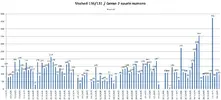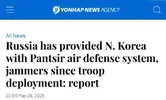Will there be 1,000 "Shaheeds" overnight? How Russia is increasing the production of kamikaze drones and strikes on Ukrainian cities
ILYA BOLGARYNOSINT analyst
JUNE 4, 2:00 PM
3086
33
The number of enemy Shahed drones and their imitators launched over Ukrainian cities is growing year by year. If in August 2024 the Russians launched 800 drones and this caused concern, now they can launch that many in a matter of days.
In March 2025, the Russians set a record and used 4,196 units. Launching thousands of drones every month has now become the new norm for Ukrainian air defense.
The growing number of drones in itself does not mean disaster, because Ukraine is also adapting and inventing new air defense means. But the Russians are constantly modernizing their "Shaheeds". Now they fly higher, hit harder, have drone simulators, better navigate in space and are more protected from the effects of electronic warfare.
The Iranian "Shahed" has been transformed into a unified Russian platform, which is being experimented with, improved, different versions with different components are being produced, and quickly put on the assembly line.
What is more unpleasant is that Russia is making production really massive. As the "Oborontsi" in the Main Intelligence Directorate (GUR) told us, the current daily production of "Shaheeds" and their imitators is estimated at 170 pieces. The plans are to produce even more, which will be another challenge for Ukrainian engineers and the military.
"Shaheeds" are becoming more numerous
The enemy received the first hundreds of Shahed drones from Iran back in 2022. There was no production in Russia at that time. The frequency of use was low, as it was completely dependent on Iranian supplies.
But everything changed in the summer of 2023, when Russia began to independently produce the "Shahed-136". The plant was set up in the "Alabuga" special economic zone, in the city of Yelabuga, 1,200 km from the front line. It produces drones called "Geran-2" - a localized version of the Iranian drone. Since then, the number of attacks has begun to systematically increase.
If from September 2023 to July 2024, Russia launched from 250 to 500 drones per month, then in November 2024 this figure exceeded 2,000 for the first time, and in March 2025 a record was recorded - over 4,000 units.

This rapid increase in numbers is partly due to the use of decoy drones such as Gerber-2 and Parody. Their purpose is to distract Ukrainian air defense fire and clear the way for the real "Shaheeds", which carry a lot of explosives and hit the target.
From a technical point of view, the Gerbera-2 and Parody are simple drones made of cheap materials such as plywood and foam. Inside, they contain a special element -
a "Lüneberg lens", which increases its size on radars and imitates real "Shaheeds". The imitation drones do not have a guidance system or protection against electronic warfare. Because of this, they often crash after running out of fuel or are suppressed by electronic warfare, which is recorded in the reports as "locationally lost". However, some of these drones have been found to contain a certain amount of explosives, so they still pose a danger.

Drone with Luneberg Lens in Russian Drone / Telegram Channel Colonel General
Ukraine was able to withstand such an invasion of kamikaze drones with "clones" only thanks to innovative solutions.
The Defense Forces have created mobile fire groups (MWGs) that specialize in destroying kamikaze drones. These are units that operate from stationary positions at heights, pickup trucks, trucks equipped with machine guns, anti-aircraft guns or MANPADS. They have thermal imagers and powerful searchlights that detect targets at night. The fight against drones also involves large air defense assets, tactical aviation, helicopters, electronic warfare systems and specialized interceptor drones.
Due to this, the effectiveness of countering these drones remains high. According to
Shahed Tracker , which analyzes data from the Ukrainian Air Force, on average, about 85% of all drones are destroyed. However, this figure may vary depending on the location of Ukrainian air defense systems in the area, their density, and the distance to the border with the Russian Federation.
Due to the complexity and number of such attacks, the Air Force is sometimes forced to use expensive means, in particular missiles from the Patriot or NASAMS systems. The cost of one such missile can exceed the cost of the kamikaze drone itself by dozens of times. So even shooting down one "Shahed" with an expensive air defense missile is a small victory for Russia.

Markings of those shot down as “shaheeds” on the MIM-104 “Patriot” air defense system / YouTube of the Ukrainian Air Force
Navigation protection, Ukrainian SIM cards and improved warheads
Along with the number of attacks, their quality is increasing. As Taras Tymochko, a consultant to the "Return Alive" foundation, told "Oborontsi", one of the key elements of the attacks is detailed planning and reconnaissance. The Russian military is constantly changing the routes and flight altitudes of drones, analyzing both intelligence data and open information in order to adapt to changes in the Ukrainian air defense system.
According to him, after Ukrainian mobile fire groups and helicopters began destroying drones at low altitudes, Russia began launching them at altitudes of 1,500 to 3,000 meters, where they are more difficult to intercept with small arms or artillery.
The Russians are also improving the technology of the drones themselves. The Shahed configurations in 2022 and 2025 are very different.
As the "Oborontsi" told the GUR, in the last year alone, several key changes have been made to the design of the "Shahedi".
The first is
a significant modification of the warheads . In addition to the standard high-explosive and high-explosive fragmentation, drones can now be equipped with combined high-explosive-fragmentation, as well as high-explosive-fragmentation-incendiary. In human terms, this means that different types of warheads are specially selected for each specific target to increase damage. For example, the high-explosive part more effectively penetrates thick walls or metal structures, and the incendiary part causes fires after the explosion.
Second,
the mass of the explosives has increased from 50 to 90 kg, which increases its destructive power.
Third, some drones are now
equipped with Starlink terminals , which allows them to be controlled in real time. This opens up new possibilities for trajectory correction in flight and precise target engagement.

A rescuer from the State Emergency Service demins a 90 kg warhead of the “Shaheda” / photo from the State Emergency Service
Another important change in the "Shaheda" technology, which has already become a myth, is
the ability to connect to the Ukrainian mobile network .
The Economist article mentioned that the Russian "Shaheeds" are allegedly controlled via Telegram bots thanks to Ukrainian SIM cards. However, this information was denied by the Ukrainian specialist in military radio technologies
Serhiy Flesh . According to him, the "Shaheeds" are not controlled via Telegram. They, as before, use satellite navigation, and Telegram bots are used only to transmit the coordinates of the drone. Data transmission is carried out via installed LTE modems - the same ones are on mobile phones to access the network.
According to the GUR, mobile communication modules for data and video transmission are indeed being installed on the "Shaheds". This allows recording the operation of Ukrainian air defense and electronic warfare systems and adjusting routes.
The technology of countering electronic warfare (EW ) is also evolving on the Shahed . In general, it is quite simple to suppress a drone that works on satellite GPS navigation. For example, by using spoofing. This is when the EW system imitates a satellite signal and replaces it with a false one, misleading the drone. That is why many Russian drones magically end up in Belarus during the attack on Kyiv.
But the Russians have begun to protect their signal receivers with special CRPA antennas that can ignore false satellite signals. Such antennas can have several "elements." The more elements, the more sources of false signals from electronic warfare (EW) the drone can "filter out" at the same time.
For example, if a CRPA antenna has four elements, then for effective signal suppression it is desirable to have at least four sources of interference (EW systems), which must also be correctly positioned relative to the target.
So, on some "Shahedas" CRPA antennas with 16 elements have already
been found , which makes their suppression much more difficult.

Chinese-made CRPA antenna with 16 elements / photo by Sergey Flesh
Russia often produces CRPA antennas on its own, called "Comet." According to Timochko, it is one of the most expensive components of a drone's design and accounts for a significant portion of its cost.
Production in Yelabuga is growing
In April 2024, Ukraine struck a Shahed plant in the city of Yelabuga. This was the first attack on the facility. But so far, we are talking about isolated cases of damage and extremely limited destruction, because the plant is located deep in the rear - more than 1,200 km from the Ukrainian border.
It is at this plant that the production of Geran-2 drones and decoy drones has been established. The production of Geran is based on Iranian developments, which have been adapted to the realities of the front and the capabilities of Russian industry.

Ukrainian drone before explosion at a factory in the Alabuga special economic zone
As Roman Steblevsky, a senior analyst for the Trap Aggressor project at the StateWatch think tank , explained to Oborontsi , Russian specialists were able to simplify the production of the drone body thanks to the new coating, but it has worse radio-absorbing properties, which makes the drones more visible on radar. Russia produces some of the body elements independently, while others are supplied from Belarus and China. At the same time, key components – in particular avionics and engine elements – continue to come from Iran.
In general, there are several series of Russian "Shaheds", which differ in design, electronics and origin. As
the Telegram channel "Colonel GSh" wrote , the letter "M" on the body denotes the original Iranian "Shahed-136". The series with the letters "Ы" and "Ъ" are modernized versions of Iranian drones, which are already assembled in Russia. The "K" series are completely Russian versions - with a carbon fuselage, a Russian-made warhead and a "Comet" CRPA antenna. In addition, an experimental modification with a jet engine called "MJ" was recorded, but only a few units of such devices are currently known.

Downed Shahed-136 / Telegram channel Colonel General Staff
In 2022, the cost of one drone in the merged documentation was $196,000. However, what it is now, taking into account the scale-up and Russian modernizations, is unknown.
The Air Force has reported launching more than 28,000 Shahed and decoy drones since then. As of mid-May 2025, according to the GUR, Russia is producing about 170 Shahed drones per day, including simulators. By the end of the year, the Kremlin plans to increase this figure to 190 units per day.
The International Institute for Strategic Studies (IISS) has recorded that the area for drone production in Yelabuga has doubled since 2023. 5 new buildings have appeared at the facility, some of which are equipped with protective structures against Ukrainian drones and are surrounded by a fence.

Shahediv Plant/ IISS
The main deterrent to further expansion of production in the GUR is considered to be the lack of workers. That is why people are brought to Yelabuga from all over the world, especially from Africa and Central Asia, who come to the city under the pretext of training, but in reality develop and assemble deadly weapons that attack Ukrainian cities. It is likely that they are the ones who are designated in the previously merged
staff list as "Tajiks" and "mulattoes."
At the same time, the GUR does not rule out that over the next few years Russia will be able to gradually scale production to 500 drones per day.
Components from China and beyond
Russian "Shaheeds" are very dependent on imported components. This is a technological product, the production of which Russian industry cannot handle on its own.
The Russian UAV industry's reliance on China no longer requires secrecy. According to Steblevsky, in 2023, Chinese companies
supplied Russia with electronics, optics, and engines for UAVs worth at least $8 million.
More and more often, downed Shaheds are found with CRPA antennas with Chinese chips manufactured by BMTI, which have become a replacement for Western counterparts such as Virtex, Xilinx, and Kintex.
At the same time, China is only the second "donor" of electronic components for these drones. According to the GUR
War&Sanctions project , in the second half of 2024, the largest number of components in the "Shaheeds" came from the USA (171 items), followed by China (46), Switzerland (32), and Japan (11).
Some of the Russian Comet CRPA antennas are still assembled on the basis of American matrices from Xilinx Inc. (AMD) or Cyclone V from Altera Corporation (Intel).

Number of components used in the production of “Shaheeds” and producing countries / Trap Aggressor graph
Steblevsky believes that it is possible to make it more difficult for Russians to access components. First, control over existing restrictions should be strengthened. The US is actively investigating illegal supplies, and large international companies are forced to report to the government. The second step is constant monitoring of potentially critical components that are not yet banned, but can be used in the production of drones. For example, there was a case when German companies supplied composite materials to Russia, and Russian importers turned out to be connected to the production of "Shaheeds". Formally, such products do not fall under EU export bans, but in fact they can be used for military purposes. Therefore, EU countries should more actively monitor supply processes and expand sanctions lists in a timely manner. But the most effective solution would be to introduce a complete embargo on trade with Russia, which would avoid such mistakes and direct all resources to strengthening control over the implementation of sanctions.
Well, while there are still a lot of holes in the sanctions, and Moscow is finding people to expand production areas in Yelabuga, the number of strikes by the "Shaheds" will continue to grow.
Of course, today Russia does not have the technical ability to carry out massive attacks with "swarms" of drones in the amount of 1,000 units in one night. Theoretically, such a possibility exists, but for its implementation it is necessary to accumulate drones for several days, as well as to equip special launch pads capable of simultaneously launching a large number of devices.
At the same time, the involvement of students and migrant workers from all over the world in their assembly, the use of imported parts despite sanctions, the deployment of domestic component production, and the technical modernization of the platform indicate a systematic and long-term approach to the use of the Shahed. This means that the number of attacks may not only remain at a high level, but also increase - especially in the case of the accumulation of drones for mass launches.
For Ukraine, this will not mean a catastrophe, but the military and engineers should prepare for a further increase in the threat. The means of countering the "Shaheeds" are: from the effective use of electronic warfare systems and the development of interceptor drones to the further expansion of traditional air defense systems. After all, there is always room to increase the effectiveness of military units that operate these means. So much will depend on the flexibility and timeliness of management decisions and the allocation of state funding for them.
Every Ukrainian can join in building "anti-shaheed defense." It's just that right now, the army, with the help of volunteers and military commanders, is implementing drone interceptor technology and building the infrastructure for their use.
The charity foundation "Return Alive" mentioned in the text is developing the "Drone Drop" project, which aims to make the use of interceptor drones truly massive. Currently, they destroy enemy reconnaissance drones, but engineers and the military are gradually gaining experience and finding ways to catch up with the "Shaheeds" and their imitators.
To accelerate the emergence of new solutions and more efficient operators, technology needs to be scaled. And scaling requires money.
You can join "Drone Drop" at this link .

 7x — Tu-95
7x — Tu-95 1x — An-12
1x — An-12















